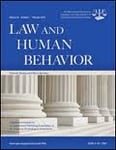 Callous-Unemotional (CU) traits are associated with a greater likelihood of adolescents offending in groups and being in a gang. Additionally CU traits are associated with taking a leadership role within group offending, as well as with greater levels of planning in the group offense. This is the bottom line of a recently published article in Law and Human Behavior. Below is a summary of the research and findings as well as a translation of this research into practice.
Callous-Unemotional (CU) traits are associated with a greater likelihood of adolescents offending in groups and being in a gang. Additionally CU traits are associated with taking a leadership role within group offending, as well as with greater levels of planning in the group offense. This is the bottom line of a recently published article in Law and Human Behavior. Below is a summary of the research and findings as well as a translation of this research into practice.
Featured Article | Law and Human Behavior | 2015, Vol. 39, No. 4, 368-377
Callous-Unemotional Traits and Adolescents’ Role in Group Crime
Author
Laura C. Thornton, University of New Orleans
Paul J. Frick
, University of New Orleans and Australian Catholic University
Elizabeth P. Shulman, Brock University
James V. Ray, University of Texas at San Antonio
Laurence Steinberg,
Temple University and King Abdulaziz University
James V. Ray, University of Texas at San Antonio
Elizabeth Cauffman, University of California at Irvine
Abstract
The current study examined the association of callous-unemotional (CU) traits with group offending (i.e., committing a crime with others; gang involvement) and with the role that the offender may play in a group offense (e.g., being the leader). This analysis was conducted in an ethnically and racially diverse sample (N=1,216) of justice-involved adolescents (ages 13 to 17) from 3 different sites. CU traits were associated with a greater likelihood of the adolescent offending in groups and being in a gang. Importantly, both associations remained significant after controlling for the adolescent’s age, level of intelligence, race and ethnicity, and level of impulse control. The association of CU traits with gang membership also remained significant after controlling for the adolescent’s history of delinquent behavior. Further, CU traits were associated with several measures of taking a leadership role in group crimes. CU traits were also associated with greater levels of planning in the group offense for which the adolescent was arrested, although this was moderated by the adolescent’s race and was not found in Black youth. These results highlight the importance of CU traits for understanding the group process involved in delinquent acts committed by adolescents. They also underscore the importance of enhancing the effectiveness of treatments for these traits in order to reduce juvenile delinquency.
Keywords
adolescents, callous-unemotional (CU) traits, delinquency, gang membership, group offending
Summary of the Research
Past research conducted on juvenile delinquency has indicated three comprehensive findings regarding adolescent offending. First, most adolescent crime is committed in groups and it is rare to find antisocial adolescents who only commit crimes alone. Second, association with deviant peers is highest in adolescents who have developmentally inappropriate levels of callous and unemotional (CU) traits (i.e., deficits in empathy). Third, adolescents with higher levels of CU traits, in comparison to other antisocial adolescents, are more likely to commit crimes in groups. Taken together, research has consistently demonstrated that adolescents frequently offend with deviant peers in groups, especially when the adolescent has higher levels of CU traits.
In an attempt to replicate previous findings outside a serious offender sample, the current study utilized a sample of first-time adolescent males in the juvenile justice system across three states. “We assumed, based on past work, that the majority of crime in the adolescent sample would be committed in groups and we asked the adolescents to report on their role in a crime committed with others. From these data, we tested the prediction that CU traits would be associated with adolescents reporting that the crime was less spontaneous and that they played a leadership role in planning and carrying out the crimes committed with others” (p. 369).
Researchers controlled for several variables that were likely to be associated with both CU traits and being the leader in a group crime: adolescents’ history of offending behavior, intelligence, and impulse control. Age and race or ethnicity were considered as potential moderators in the association of CU traits and adolescent group crime.
Results suggested that CU traits have an association with adolescents’ participation in group crime and being in a gang, which is consistent with previous findings. However, results indicated that “the association between CU traits and group offending was not independent of the number of previous offenses reported by the adolescent, whereas the association between CU traits and gang membership was independent of previous offending” (p. 373). This finding could indicate that “gang membership is indicative of more than just group offending” (p. 373).
The findings of this study also contribute to our understanding of the association between CU traits and adolescents’ report of taking a leadership role in group crimes. “CU traits were related to taking a leadership role in group crimes and this was independent of the adolescent’s age, race/ethnicity, intelligence, and level of impulse control. However, for only one of these three variables (i.e., endorsing a leadership role in past offenses) did this association remain significant after controlling for the adolescent’s history of offending” (p 373).
“Influence on peers may be related to adolescents with CU traits having the skills and motivation to manipulate and exploit others. However, it is also possible that adolescents with elevated CU traits show higher levels of narcissistic traits and these traits may make them more likely to perceive themselves as leaders and overestimate the importance of their roles in group crimes” (p. 373).
“Contrary to predictions, CU traits were not negatively associated with the crime being unplanned and spontaneous. This finding is inconsistent with results from samples of adolescents incarcerated in adult prisons for serious violent crimes and adolescents who committed sex offenses, in which CU traits were associated with greater levels of planning and premeditation. One possible reason for this inconsistent finding may be that this association is only found among adolescents who commit more severe and often violent offenses. However, our findings suggested another possible explanation. Specifically, we found an interaction between CU traits and race/ethnicity in the likelihood of committing an unplanned and spontaneous act. That is, for White non-Latino adolescents, those higher in CU traits were less likely to report that the index offense had “just happened,” whereas for Black adolescents, there was no association between these variables.”(p. 374).
Translating Research into Practice
Clinicians may benefit from understanding the role that CU traits play in offenses committed by adolescents. Adolescents who displayed higher levels of CU traits were found to play a more dominant role in the commission of the offenses. This study also highlighted the importance of parsing out gang related crime from general group crime, as CU traits contribute to gang membership and “gang membership may be indicative of a more serious and chronic pattern of offending” (p 373).
“Findings that CU traits are related to gang membership and taking a leadership role in group offending highlight the importance of improving treatment for adolescents with CU traits, and the promise that such interventions might hold for reducing juvenile crime more generally. In the past, persons with CU traits have been considered to be resistant to treatments, but recent work suggests that adolescents with elevated CU traits do respond to intensive multi-component treatments that are tailored to their unique emotional, cognitive, and motivation styles” (p. 376). The development of effective treatment for adolescents with CU traits, particularly those adolescents who are in contact with the juvenile justice system, may reduce the incidence of juvenile crime.
Other Interesting Tidbits for Researchers and Clinicians
“The predicted association of CU traits with the probability of committing the index offense with others was not found among Black youth. Similarly, the association between CU traits and lifetime group offending was weaker for Black adolescents. Also, the association between CU traits and being the leader of the index group offense was not observed among Black youth.
Results suggest that future studies should explore whether CU traits are related to group offending differently for Black adolescents compared with adolescents of other ethnicities or whether findings that rely solely on official records lead to differences in findings across ethnic groups because of differential processing by the juvenile justice system” (p. 374).
Join the Discussion
As always, please join the discussion below if you have thoughts or comments to add!







